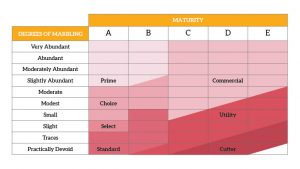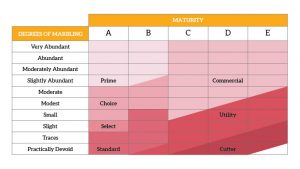Picture this: you walk into Joe’s and are looking for a delicious steak for dinner. Here’s the catch – you don’t necessarily know what Joe’s Reserve and Joe’s Dry Age means. With options including USDA Prime, Choice and Select, available at the grocery, the different types of meat choices can seem overwhelming.
Beef Grading is a subject that you could spend hours learning about and still not master or understand all of the nuances. To prepare you for your next visit, we’ve provided a guide that shares the basics of what you need to know. If you still feel like your head is spinning after reading, just grab Joe on the floor of the store and he’ll be sure to help…and possibly bore you to tears with the details.
Key Concepts:
- Beef Grading is all about determining the amount of intramuscular marbling present in the meat and cattle’s age. Marbling makes cuts more tender since it melts when heated.
- The amount of marbling and cattle’s age is responsible for one-half of meat quality. Other factors include: the cattle’s diet, conditions at slaughter, breed, and storage of the meat.
- Beef Grading occurs at the premise of the meatpacker and they pay a USDA inspector for the grading service. Inspectors use a computer-aided camera to take pictures of the ribeye only and use this to grade the entire carcass. The meat is then assigned a maturity and USDA grade.
- Grade A meat comes from cattle that were 9-30 months of age, versus Grade E meat which accounts for 8-year-old cattle.
- Young cattle with sufficient marbling are given USDA Prime, Choice, or Select grades, while Standard and Commercial grades are usually sold ungraded, and the lowest grades—Utility, Cutter, and Canner—are used to make processed beef products (think beef sticks, soups, canned stew, animal feeds, etc.).
- In 1975 and in the early 2000s, the USDA inspectors adjusted their camera comparison standards for what constitutes Select/Standard versus Choice beef, but not Prime. Why? The claim was that consumers wanted leaner meats, so they lowered their standards for the Choice Grade (i.e. what used to be the top of Select became the bottom of Choice.).
Takeaways from the chart:
- Steers (castrated males) can be graded Select, Choice or Prime. Cows (female) and Bulls (intact males) are not graded. In general, if a farmer wants higher graded cattle, they have to feed them more rich nutrients and for longer periods.
- Inside each marbling category, there are 100 points of marbling! Very Abundant (VA) can range from VA-0 to VA-100. This goes down the line through Small. Between Small and Very Abundant, there are 700 points of marbling on the computer! As you move from 0 to 700 on the scale, the cost of the beef increases to the grocer or butcher.
- Prime beef comes from young cattle (A or B maturity). Less than 3% of U.S. meat is graded Prime.
- Meat from Choice cattle comes from young (A or B maturity) cattle.
- Found at grocery stores, Select beef has a slight marbling and comes from young cattle only (A maturity).
- Standard Beef does not have a grading stamp rolled onto the carcass and is often called No-Roll Beef.
We get it. There are a lot of facts above and you’re probably still looking for clarity and conclusions. Here we go:
- Groceries don’t provide consistently tender meats because they source border line meats from the chart above. They can buy Grade A; Small 0-50 or Grade B; Modest 0-50 and blanket sell it to you as USDA Choice for a greater profit.
- Chain groceries are on program-buys with meat packers. This means that they are paying a set price all year and USDA Choice beef is being delivered at very large quantities. This gives incentive to meatpackers to deliver the lowest cost of USDA Choice possible.
- Certain groceries buy Grade B; Small 0-100 (Standard/No-Roll) or Grade A; Small 0-100 (Select) and sell it as “insert chain grocery store name” Choice! No law states that they cannot call meat without the USDA name.
- Given the marbling grading changes instituted by the USDA over the years, today’s low USDA Choice beef is yesterday’s Select and No-Roll beef.
- Joe’s Reserve Beef consistently grades as USDA Choice Moderate 50 to USDA Prime Slightly Abundant 100 (the top 1/6th of USDA Choice to bottom 1/3rd USDA Prime).
- Joe’s Dry Age grades as USDA Choice Modest to Moderate (upper 2/3 USDA Choice) and is locally grown and processed, then hung whole carcass for 21 to 28 days for tenderness.
The biggest takeaway from all of this is that Joe’s Butcher Shop literally and figuratively brings value to your table. At Joe’s we source from local, small farms or from boutique beef growing programs that promise a consistently better product. As the grade and degree of marbling increase, the supply decreases. Because of this, Joe’s can take advantage of this smaller supply and ensure that you have a consistent marbling experience at an affordable price. Last, but certainly not least, Joe’s is closer to the food chain source and we can discern all of the qualities that are needed for highest quality beef including the cattle’s diet, lack of hormones and antibiotics, breed, the stress during processing and the storage of the meat. Let our meat do the talking and stop into Joe’s today.


